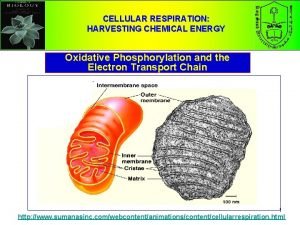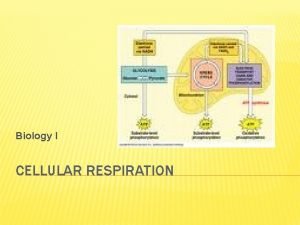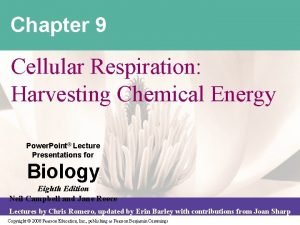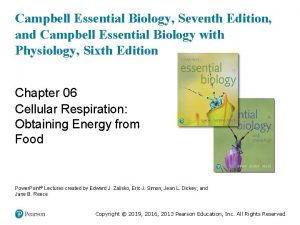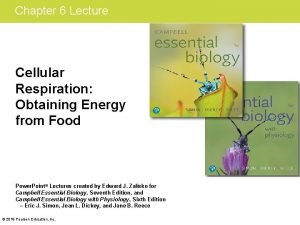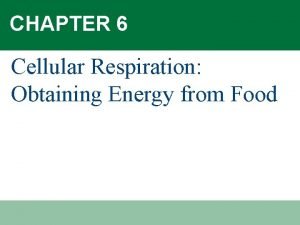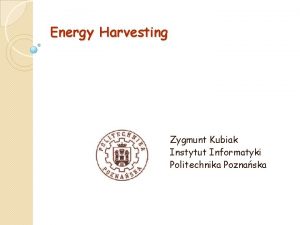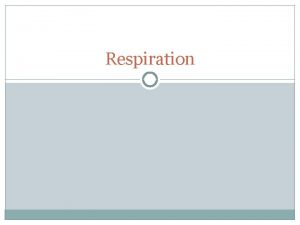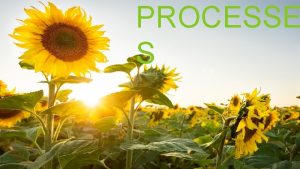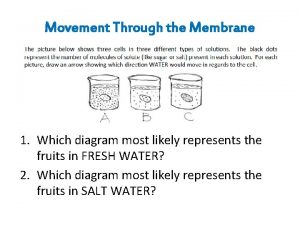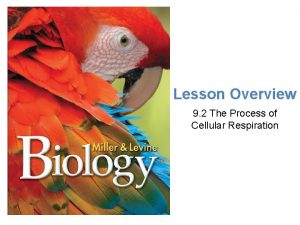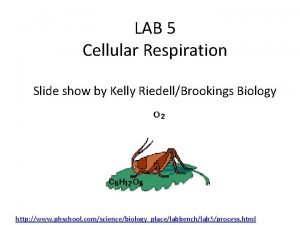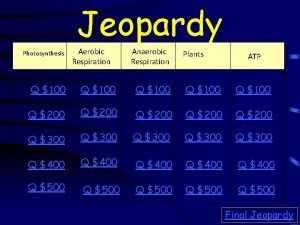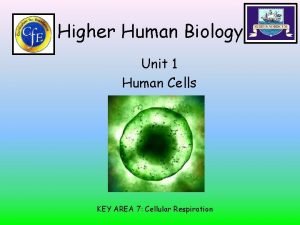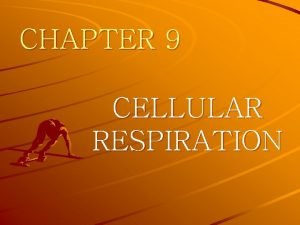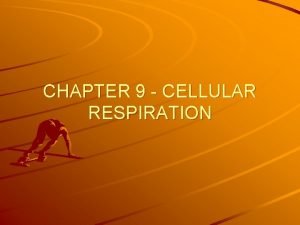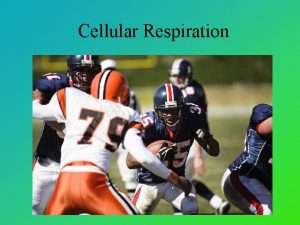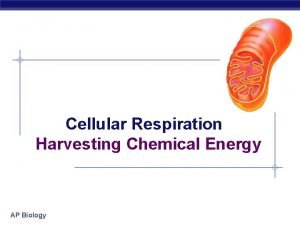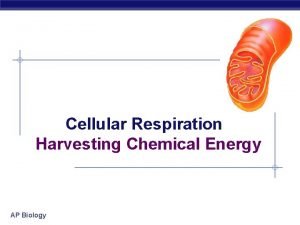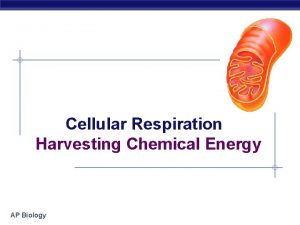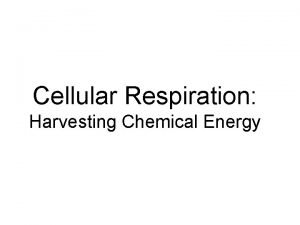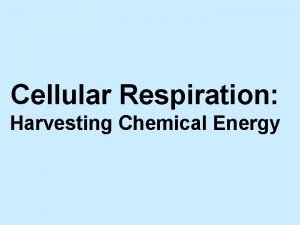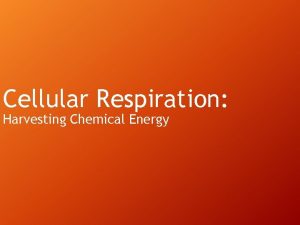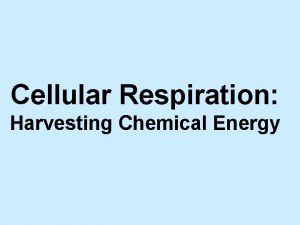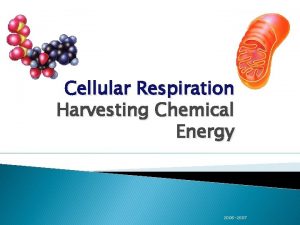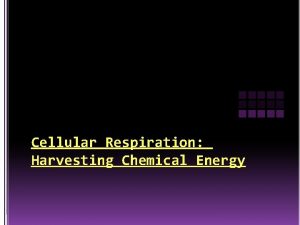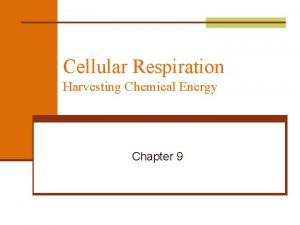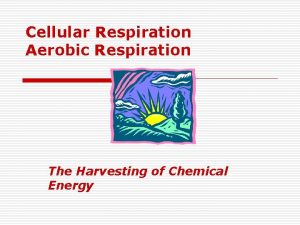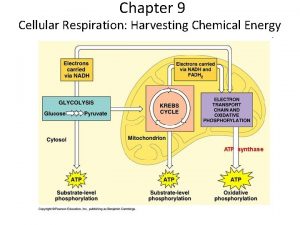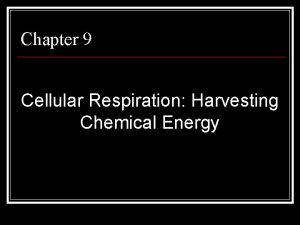Ch 6 Cellular Respiration Harvesting Chemical Energy Cellular


































- Slides: 34

Ch. 6: Cellular Respiration Harvesting Chemical Energy

Cellular Respiration: An Overview A cellular process that breaks down nutrient molecules with the production of ATP � Consumes (CO 2) oxygen and produces carbon dioxide ◦ Cellular respiration is an aerobic process. � Usually involves the complete breakdown of glucose to CO 2 and H 2 O � Occurs in 3 steps

Overview �Cellular respiration is an exergonic ◦ produces up to 32 ATP molecules from each glucose molecule ◦ captures only about 34% of the energy originally stored in glucose Other foods (organic molecules) can also be used as a source of energy.

Figure 6. 2 O 2 Breathing CO 2 Lungs CO 2 Bloodstream O 2 Muscle cells carrying out Cellular Respiration Glucose O 2 CO 2 H 2 O ATP

Cellular Respiration: An Overview

Cellular Respiration: An Overview �Terms to Know… ◦ Oxidation = the loss of electrons �Compound becomes more positive ◦ Reduction = the gain of electrons �Compound becomes more negative ◦ Electrons and protons (H+) travel TOGETHER

Oxidation C 6 H 12 O 6 + 6 O 2 6 CO 2 + 6 H 2 O + energy glucose Reduction l l Electrons are removed from substrates and received by oxygen, which combines with H+ to become water. Glucose is oxidized and O 2 is reduced

Important enzymes NAD+ ◦ A coenzyme of oxidation-reduction. ◦ Each NAD+ molecule is used over and over again ◦ Reduced into NADH �Accepts 2 electrons plus a hydrogen ion (H+) �FAD ◦ Also a coenzyme of oxidation-reduction ◦ Sometimes used instead of NAD+ ◦ Reduced into FADH 2 �Accepts two electrons and two hydrogen ions (H+)

Respiration �Respiration is a cumulative function of 3 metabolic stages ◦ Glycolysis �Only reactions that takes place outside of mitochondria and doesn’t require O 2 ◦ Citric acid cycle (Krebs Cycle) ◦ Oxidative Phosphorylation �Electron transport chain (ETC)

Cellular Respiration Glucose Glycolysis Oxygen Absent ATP Oxygen Present Anaerobic Respiration Aerobic Respiration (Fermentation) (Krebs Cycle & ETC) ATP

Glycolysis �“glucose-splitting” �Big Picture: ◦ Glucose (6 -C) is broken down into 2 molecules of pyruvate (3 -C) �Occurs in the cytoplasm �Occurs without oxygen �Oxidation results in NADH �Made up of 2 phases: and 2 ATP ◦ Energy investment phase ◦ Energy yielding (payoff) phase

Glycolysis: Energy Investment Phase �Glucose is converted into 2 G 3 P (Glyceraldehyde-3 phosphate) �Requires 2 ATP

Glycolysis: Energy-Yielding Phase ◦ 2 G 3 P are converted into 2 Pyruvate (3 C) molecules. ◦ Dehydrogenase enzymes remove H from intermediate compounds and attach them to 2 NAD to produce 2 NADH

Substrate-Level Phosphorylation �An enzyme transfers a phosphate group directly from an organic molecule to ADP to form ATP �The ATP produced in Glycolysis & the Krebs Cycle is produced by this method.

enzyme P ADP P BPG ATP P 3 PG

Net Gain in Glycolysis � 2 ATP - 2 ATP (Energy investment phase) + 4 ATP (Energy yielding phase) + 2 ATP � 2 NADH ◦ Electron carriers ◦ Will be used to make ATP later

Choices, Choices! �If oxygen is absent, anaerobic respiration occurs ◦ Fermentation �Yeast & some bacteria alcoholic fermentation �Animal muscle lactic acid fermentation �If oxygen is present, aerobic respiration occurs ◦ Krebs Cycle and Electron Transport Chain

Cellular Respiration Glucose Glycolysis Oxygen Absent Anaerobic Respiration ATP Oxygen Present Aerobic Respiration (Fermentation) ATP

Fermentation �Fermentation is an anaerobic process that reduces pyruvate to either lactate or alcohol and CO 2 � 2 major types: ◦ Alcoholic and lactic acid fermentation �NAD+ acts as a hydrogen acceptor during glycolysis ◦ If the supply of NAD+ runs out, then glycolysis would have to stop. ◦ Fermentation occurs as simply a means of recycling the NAD+, so that glycolysis can occur again.

Alcoholic Fermentation � Occurs in some BACTERIA and YEAST � 2 step process: ◦ Carbon dioxide is released from pyruvate (3 -C), forming acetaldehyde (2 -C) ◦ Acetaldehyde is reduced by NADH forming ethanol ◦ NAD+ is regenerated � Used wine to produce beer and

Lactic Acid Fermentation � Occurs in ANIMALS � 1 step process: ◦ Pyruvate is reduced by NADH forming lactic acid � NAD+ is regenerated � Occurs in muscle cells, causing muscle pain and fatigue � Used to make yogurt and cheese

Cellular Respiration Glucose Glycolysis Oxygen Absent Anaerobic Respiration ATP Oxygen Present Aerobic Respiration (Fermentation) ATP

Aerobic Respiration � After glycolysis, most of the energy from glucose remains “locked” in 2 molecules of pyruvate � If oxygen is present, the pyruvate enters the mitochondrial matrix to complete the Krebs Cycle Preparatory Phase: � Pyruvate (3 -C) is converted to Acetyl Co. A (2 -C) ◦ CO 2 is released as a waste product ◦ NADH is produced


The Krebs Cycle �Yield per pyruvate molecule (two turns): ◦ 3 NADH ◦ 1 FADH 2 ◦ 1 ATP �(produced via substrate level phosphorylation) ◦ 2 CO 2 �CO 2 released as ◦ We exhale this a waste product

Figure 6. 9 A Acetyl Co. A 2 CO 2 Citric Acid Cycle 3 NAD FADH 2 3 NADH FAD 3 H ATP ADP P

Electron Transport Chain (ETC) �Collection of cytochrome molecules embedded in the cristae membrane ◦ 4 reactions plus ATP synthase �Occurs in inner membrane of mitochondrion �Proton pump that produces a proton gradient that will be used to create ATP

ETC �Electrons from NADH and FADH 2 from glycolysis and the Krebs Cycle lose electrons, proton gradient �The energy in each NADH molecule moves enough protons (H+) into the mitochondrial matrix to create 3 ATP � 1 FADH 2 2 ATP

ETC �The electrons from NADH and FADH 2 are passed from one electron acceptor molecule to another. �Each electron acceptor is more electronegative than the last. �Oxygen is the final electron acceptor, producing water e- oxygen


Steps of the ETC �I- NADH reductase oxidizes NADH to NAD+ resulting in high energy electron �II- high energy electron transfers through coenzyme Q to cytochrome reductase �III- travels through the cytochrome c �IV- travels into cytochrome oxidase where it is now low energy and binds to oxygen to form water

Chemiosmosis �the energy the electrons lose along the way moves H+ out of the matrix and into the intermembrane space of the mitochondria �As H+ ions diffuse through the membrane, ATP synthase uses the energy to join ADP and a phosphate group ATP

Oxidative Phosphorylation: ETC & Chemiosmosis

Figure 6. 12 CYTOPLASM Electron shuttles across membrane 2 NADH Mitochondrion 2 NADH or 2 FADH 2 6 NADH 2 NADH Glycolysis 2 Pyruvate Glucose Pyruvate Oxidation 2 Acetyl Co. A Citric Acid Cycle 2 FADH 2 Oxidative Phosphorylation (electron transport and chemiosmosis) Maximum per glucose: 2 ATP by substrate-level phosphorylation about 28 ATP by oxidative phosphorylation About 32 ATP
 Chapter 9: cellular respiration: harvesting chemical energy
Chapter 9: cellular respiration: harvesting chemical energy Chapter 9 cellular respiration harvesting chemical energy
Chapter 9 cellular respiration harvesting chemical energy Chapter 9: cellular respiration: harvesting chemical energy
Chapter 9: cellular respiration: harvesting chemical energy Electron transport chain summary
Electron transport chain summary What plant need for photosynthesis
What plant need for photosynthesis What is cellular respiration equation
What is cellular respiration equation Chemical formula for cellular respiration
Chemical formula for cellular respiration Energy flow in cellular respiration
Energy flow in cellular respiration Chemical cycling in an ecosystem
Chemical cycling in an ecosystem Cellular respiration obtaining energy from food
Cellular respiration obtaining energy from food Cellular respiration obtaining energy from food
Cellular respiration obtaining energy from food Internal respiration vs external respiration
Internal respiration vs external respiration Respiration
Respiration Energy harvesting przykłady
Energy harvesting przykłady Chapter 8 section 1 how organisms obtain energy answer key
Chapter 8 section 1 how organisms obtain energy answer key Cellular respiration redox
Cellular respiration redox What is the correct equation for cellular respiration?
What is the correct equation for cellular respiration? Chemiosmosis steps
Chemiosmosis steps Types of respiration
Types of respiration Diagram of respiration
Diagram of respiration Why is cellular respiration important
Why is cellular respiration important Complimentary processes
Complimentary processes How are internal and external respiration alike
How are internal and external respiration alike Cellular respiration formula
Cellular respiration formula Starting materials for cellular respiration
Starting materials for cellular respiration What happens during glycolysis
What happens during glycolysis Overview of cellular respiration
Overview of cellular respiration Overview of aerobic respiration
Overview of aerobic respiration Cellular respiration
Cellular respiration Cellular respiration
Cellular respiration Lab bench cellular respiration
Lab bench cellular respiration What is the word equation for cellular respiration
What is the word equation for cellular respiration Higher human biology cellular respiration
Higher human biology cellular respiration Cellular respiration reactants
Cellular respiration reactants Cellular respiration releases
Cellular respiration releases



